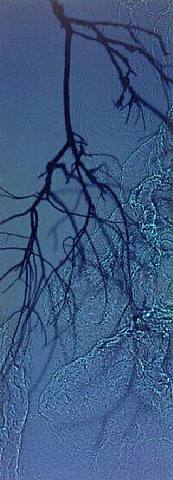Susan Derges facts for kids
Quick facts for kids
Susan Derges
|
|
|---|---|
| Born | 1955 (age 69–70) |
| Known for | camera-less photographic processes |
Susan Derges (born in 1955) is a British artist who creates amazing photographs without using a camera! She lives and works in Devon, England.
Susan is famous for her special way of making pictures. She often works with natural places like rivers and forests. Her art has been shown in many countries, including Europe, America, and Japan. You can find her work in famous museums like the Art Institute of Chicago and the Victoria and Albert Museum in London. She also received a special award from The Royal Photographic Society.
About Susan Derges
Susan Derges was born in London in 1955. When she was younger, she studied basic physics. This helped her think about how we see things and how our choices can change what we observe.
Early Art Journey
Susan started her art career as a painter in the 1970s. She studied painting at the Chelsea College of Art and Design and the Slade School of Art.
In 1980, she moved to Japan. This is where she started trying out older ways of making photographs. She began making pictures without a camera, by putting objects directly onto special photographic paper. She has been improving these unique methods ever since.
Life and Work Locations
From 1981 to 1985, Susan lived and worked in Japan. She received some awards there, like the Rotary Foundation Award. She also did research at Tsukuba University.
After Japan, she lived in London for a few years. In 1992, she moved to Dartmoor, Devon, which is a beautiful natural area. She also taught art at the University of Plymouth.
How Susan Derges Makes Art
Susan Derges is known for her "camera-less" photographs, also called photograms. This means she doesn't use a camera lens to capture images. Instead, she places things directly onto light-sensitive paper.
Connecting with Nature
Susan was first a painter, but she became interested in abstract art. She felt it could show "the invisible" rather than just what we can see. She found that a camera often made her feel separate from what she was photographing.
So, she started exploring ways to connect more directly with nature. In her art, nature itself creates the patterns. She lets falling water drops, busy honeycombs, or even tiny toad eggs leave their marks on the paper.
Susan says her ideas come from wanting to feel very close to nature, like a river. She sees the river as a way to think about being "immersed" or fully involved. She is always trying new ways to record images without a camera. She often starts with an idea that feels a bit mysterious, trying to explore her "unconscious" thoughts.
Early Experiments
Susan first tried camera-less photography in Japan. In 1985, she made a series called Chladni Figures. For these, she sprinkled powder onto photographic paper. Then, she exposed it to sound waves at different pitches. This created ghostly black and white images that showed how nature can be both orderly and chaotic.
Famous Series
- The Observer and the Observed (1991): In this series, Susan explored how the viewer and the object affect each other. She made images that looked like water droplets with faces inside them. At the same time, her own face appeared with tiny droplets in front of her eyes.
- River Taw (1997): For this series, Susan worked at night in the River Taw near her home in Devon. She placed large sheets of photographic paper right on the riverbed. The moonlight and a flash gun helped expose the images. She captured parts of ivy, ice, and other things floating in the water. This was a very direct way for her to connect with the landscape.
- Under The Moon: In this series, she combined photographs of the moon with patterns made by water and branches. She exposed these to sound vibrations in a darkroom.
- Tide Pools (2017): Susan worked with marine biologists from the University of Plymouth for this project. She was a Visiting Professor there.
Susan's pictures are often beautiful and make you think deeply. Even though they show real things from nature, they also make you think about our inner feelings and imagination.
Where to See Her Art
Susan Derges's work is kept in these important art collections:
- Art Institute of Chicago, Chicago, IL
- Metropolitan Museum, New York
- Victoria and Albert Museum, London
Awards and Honors
- 2014: She received an Honorary Fellowship from The Royal Photographic Society.


